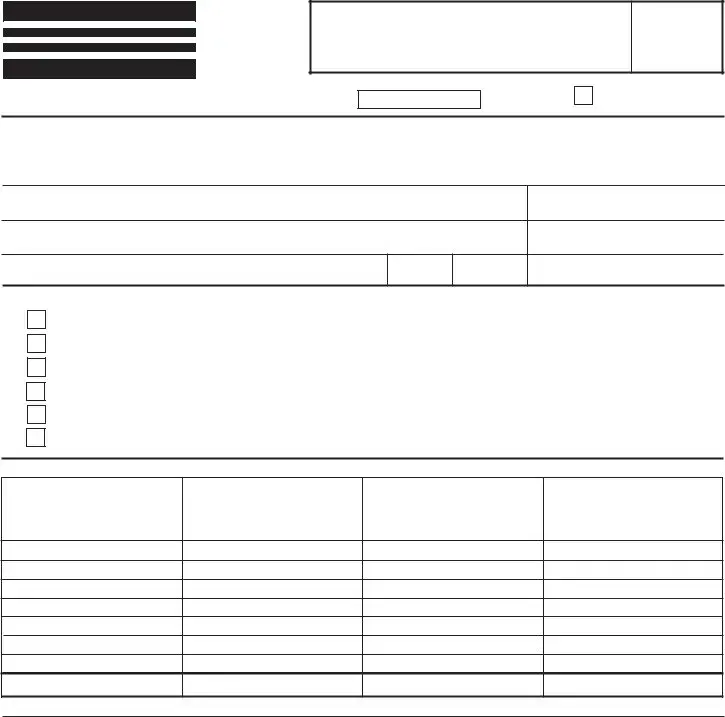The Form 941, Employer's Quarterly Federal Tax Return, shares similarities with the Utah TC-941D form in its focus on reconciling company payroll taxes. Both documents are essential for businesses to report earnings, withholdings, and payroll taxes to government tax agencies. Form 941 is a federal requirement that details the amount of income, Social Security, and Medicare taxes withheld from employees' paychecks by the employer. While the TC-941D is specific to discrepancies in annual withholding reconciliation for Utah, Form 941 serves the broader purpose of quarterly reporting on a national scale. Despite their different intervals and jurisdictional focuses, both forms play critical roles in ensuring tax compliance and accuracy in withheld payroll taxes.
The W-2, Wage and Tax Statement, is another document closely related to the Utah TC-941D form, as it provides detailed information on employee earnings and taxes withheld over the tax year. Employers are required to furnish W-2 forms to their employees and file copies with the Social Security Administration. When discrepancies arise in the reconciliation process outlined by the TC-941D, it often involves cross-referencing the figures reported on W-2 forms. The necessity to explain discrepancies between aggregated W-2 withholdings and reported amounts on the Utah Annual Withholding Reconciliation highlights their interconnection in accurately reporting and reconciling an employer's tax liability.
The 1099 series, including forms like the 1099-NEC and 1099-MISC, is akin to the TC-941D form in terms of reporting income and withholdings, but for non-employees. Similar to the role W-2s play for employee compensation, 1099 forms are used for reporting payments made to independent contractors and other non-employees. In situations where a business’s annual withholding reconciliation involves payments reported on 1099 forms, the TC-941D form becomes relevant. The process of identifying discrepancies may require an analysis of payments and withholdings reported on 1099 forms, underscoring the similarity in their use for clarifying and justifying tax withholdings to tax authorities.
Form W-3, Transmittal of Wage and Tax Statements, is closely related to the Utah TC-941D form as it accompanies W-2 forms sent to the Social Security Administration. It summarizes the total earnings, Social Security wages, Medicare wages, and withholding for all employees for the year. When discrepancies arise on the TC-941D, it's often necessary to review the W-3 to ensure the totals match what was reported throughout the year and reconciled on the Utah Annual Withholding Reconciliation. Both forms serve as summary documents that facilitate the reconciliation process and ensure compliance with reporting requirements.
The Utah Annual Withholding Reconciliation, form TC-941R, is directly related to the TC-941D discrepancy report. The TC-941R is the summary of withholding for the entire year and directly precedes the need for the TC-941D when discrepancies are discovered. The TC-941D serves as a follow-up to address and explain any differences between what was initially reported via the TC-941R and the actual withholdings for the year. The direct relationship between these forms highlights the step-by-step process Utah employs to ensure accurate withholding tax reporting and reconciliation.
Form TC-941, Utah Employer's Quarterly Withholding Return, while addressing a different reporting period, is fundamentally similar to the TC-941D in its focus on withholding tax. Employers in Utah use the TC-941 to report and pay taxes withheld from employees' wages each quarter. When discrepancies arise in annual totals, as reported on the TC-941R, the TC-941D is employed to reconcile these differences. Thus, both the quarterly and the discrepancy report forms are integral components of Utah's system for monitoring and ensuring the accuracy of withheld payroll taxes.
The Change of Entity Form, often required when a business undergoes a significant change in structure, has an indirect relation to the Utah TC-941D form. Such changes can affect the reporting and reconciliation process of withholding taxes as indicated on the TC-941D. For instance, if a business transitions from a partnership to a corporation or undergoes a merger, these structural adjustments could explain discrepancies in withholding tax reports. While the Change of Entity Form itself does not deal directly with tax withholdings, the ramifications of such changes bear significantly on the circumstances under which a TC-941D form would need to be filed.
The Amended Federal Tax Return (Form 1040-X), serves a purpose analogous to the Utah TC-941D, although in the realm of individual income taxes. When individuals discover discrepancies or need to make changes to previously filed tax returns, they use Form 1040-X to correct the record. Similarly, the TC-941D allows businesses to rectify discrepancies in reported versus actual withholding taxes. Despite serving different taxpayer categories, both forms underscore the tax systems’ mechanisms for ensuring accuracy and providing pathways to correct past submissions.
